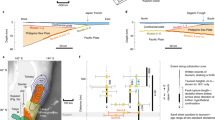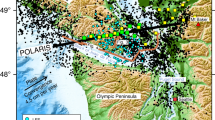Abstract
Large earthquakes nucleate at tectonic plate boundaries, and their occurrence within a plate’s interior remains rare and poorly documented, especially offshore. The two large earthquakes that struck the northeastern Indian Ocean on 11 April 2012 are an exception: they are the largest strike-slip events reported in historical times1,2 and triggered large aftershocks worldwide3. Yet they occurred within an intra-oceanic setting along the fossil fabric of the extinct Wharton basin, rather than on a discrete plate boundary4,5,6,7,8. Here we show that the 11 April 2012 twin earthquakes are part of a continuing boost of the intraplate deformation between India and Australia that followed the Aceh 2004 and Nias 2005 megathrust earthquakes, subsequent to a stress transfer process recognized at other subduction zones9,10. Using Coulomb stress change calculations, we show that the coseismic slips of the Aceh and Nias earthquakes can promote oceanic left-lateral strike-slip earthquakes on pre-existing meridian-aligned fault planes. We further show that persistent viscous relaxation in the asthenospheric mantle several years after the Aceh megathrust explains the time lag between the 2004 megathrust and the 2012 intraplate events. On a short timescale, the 2012 events provide new evidence for the interplay between megathrusts at the subduction interface and intraplate deformation offshore. On a longer geological timescale, the Australian plate, driven by slab-pull forces at the Sunda trench, is detaching from the Indian plate, which is subjected to resisting forces at the Himalayan front6,8,11.
This is a preview of subscription content, access via your institution
Access options
Subscribe to this journal
Receive 51 print issues and online access
$199.00 per year
only $3.90 per issue
Buy this article
- Purchase on Springer Link
- Instant access to full article PDF
Prices may be subject to local taxes which are calculated during checkout



Similar content being viewed by others
References
Robinson, D. P. A rare great earthquake on an oceanic fossil fracture zone. Geophys. J. Int. 186, 1121–1134 (2011)
McGuire, J. J. & Beroza, G. C. A rogue earthquake off Sumatra. Science 336, 1118–1119 (2012)
Pollitz, F. F., Stein, R. S., Sevilgen, V. & Bürgmann, R. The 11 April 2012 east Indian Ocean earthquake triggered large aftershocks worldwide. Nature http://dx.doi.org/10.1038/nature11504 (this issue).
Deplus, C. et al. Direct evidence of active deformation in the eastern Indian oceanic plate. Geology 26, 131–134 (1998)
Tinnon, M., Holt, W. E. & Haines, A. J. Velocity gradients in the northern Indian Ocean inferred from earthquake moment tensors and relative plate velocities. J. Geophys. Res. 100, 24315–24329 (1995)
Deplus, C. Indian Ocean actively deforms. Science 292, 1850–1851 (2001)
Abercrombie, R. E., Antolik, M. & Ekstrom, G. The June 2000 Mw 7.9 earthquakes south of Sumatra: deformation in the India-Australia plate. J. Geophys. Res. 108 2018, http://dx.doi.org/10.1029/2001JB000674 (2003)
Delescluse, M. & Chamot-Rooke, N. Instantaneous deformation and kinematics of the India-Australia plate. Geophys. J. Int. 168, 818–842 (2007)
Dmowska, R., Rice, J. R., Lovison, L. C. & Josell, D. Stress transfer and seismic phenomena in coupled subduction zones during the earthquake cycle. J. Geophys. Res. 93, 7869–7884 (1988)
Lay, T., Ammon, C. J., Kanamori, H., Xue, L. & Kim, M. J. Possible large near-trench slip during the 2011 Mw 9.0 off the Pacific coast Tohoku earthquake. Earth Planets Space 63, 713–718 (2011)
Gerbault, M. At what stress level is the central Indian Ocean lithosphere buckling? Earth Planet. Sci. Lett. 178, 165–181 (2000)
Rajendran, K., Andrade, V. & Rajendran, C. P. The June 2010 Nicobar earthquake: fault reactivation on the subducting oceanic plate. Bull. Seismol. Soc. Am. 101, 2568–2577 (2011)
Graindorge, D. et al. Impact of lower plate structure on upper plate deformation at the NW Sumatran convergent margin from seafloor morphology. Earth Planet. Sci. Lett. 275, 201–210 (2008)
Satriano, C., Kiraly, E., Bernard, P. & Vilotte, J. P. The 2012 Mw 8.6 Sumatra earthquake: evidence of westward sequential seismic ruptures associated to the reactivation of a N-S ocean fabric. Geophys. Res. Lett. 39, L00B07, http://dx.doi.org/10.1029/2012GL052387 (2012)
Hwang, L. J. & Kanamori, H. Rupture process of the 1987–1988 Gulf of Alaska earthquake sequence. J. Geophys. Res. 97, 19881–19908 (1992)
Yue, H., Lay, T. & Koper, K. D. En échelon and orthogonal fault ruptures of the 11 April 2012 great intraplate earthquakes. Nature http://dx.doi.org/10.1038/nature11492 (this issue).
Meng, L. et al. Earthquake in a maze: compressional rupture branching during the 2012 Mw 8.6 Sumatra earthquake. Science 337, 724–726 (2012)
Royer, J. Y., Gordon, R. G., DeMets, C. & Vogt, P. R. New limits on the motion between India and Australia since Chron 5 (11 Ma) and implications for lithospheric deformation in the equatorial Indian Ocean. Geophys. J. Int. 129, 41–74 (1997)
Bull, J. M. & Scrutton, R. A. Fault reactivation in the central Indian Ocean and the rheology of oceanic lithosphere. Nature 344, 855–858 (1990)
Chamot-Rooke, N. et al. Intraplate shortening in the central Indian Ocean determined from a 2100-km-long north-south deep seismic reflection profile. Geology 21, 1043–1046 (1993)
Delescluse, M., Montési, L. G. J. & Chamot-Rooke, N. Fault reactivation and selective abandonment in the oceanic lithosphere. Geophys. Res. Lett. 35, L16312, http://dx.doi.org/10.1029/2008GL035066 (2008)
Haines, A. J. & Holt, W. E. A procedure for obtaining the complete horizontal motions within zones of distributed deformation from the inversion of strain rate data. J. Geophys. Res. 98, 12057–12082 (1993)
Cattin, R. et al. Stress change and effective friction coefficient along the Sumatra-Andaman-Sagaing fault system after the 26 December 2004 (Mw = 9.2) and the 28 March 2005 (Mw = 8.7) earthquakes. Geochem. Geophys. Geosyst. 10, Q03011, http://dx.doi.org/10.1029/2008GC002167 (2009)
Rhie, J., Dreger, D., Bürgmann, R. & Romanowicz, B. Slip of the 2004 Sumatra-Andaman earthquake from joint inversion of long-period global seismic waveforms and GPS static offsets. Bull. Seismol. Soc. Am. 97, S115–S127 (2007)
Ji, C. Preliminary result of the March 28, 2005 Mw 8.68 Nias earthquake. http://www.geol.ucsb.edu/faculty/ji/big_earthquakes/2005/03/smooth/nias.html (2005)
Vigny, C. et al. Insight into the 2004 Sumatra-Andaman earthquake from GPS measurements in southeast Asia. Nature 436, 201–206 (2005)
Chlieh, M. et al. Coseismic slip and afterslip of the great Mw 9.15 Sumatra-Andaman earthquake of 2004. Bull. Seismol. Soc. Am. 97, S152–S173 (2007)
Briggs, R. et al. Deformation and slip along the Sunda megathrust in the great 2005 Nias-Simeulue earthquake. Science 311, 1897–1901 (2006)
Banerjee, P., Pollitz, F., Nagarajan, B. & Bürgmann, R. Coseismic slip distributions of the 26 December 2004 Sumatra-Andaman and 28 March 2005 Nias earthquakes from GPS static offsets. Bull. Seismol. Soc. Am. 97, S86–S102 (2007)
Fujiwara, T. et al. The 2011 Tohoku-Oki earthquake: displacement reaching the trench axis. Science 334, 1240 (2011)
Vigny, C. et al. The 2010 Mw 8.8 Maule megathrust earthquake of Central Chile, monitored by GPS. Science 332, 1417–1421 (2011)
Fleitout, L. et al. Far away motions associated with giant subduction earthquakes and the mechanical properties of the lithosphere-asthenosphere system. Geophys. Res. Abs. 14, EGU2012–10899 (2012 EGU General Assembly, 2012)
DeMets, C., Gordon, R. G. & Argus, D. F. Geologically current plate motions. Geophys. J. Int. 181, 1–80 (2010)
Ji, C., Wald, D. J. & Helmberger, D. V. Source description of the 1999 Hector Mine, California earthquake; part I: wavelet domain inversion theory and resolution analysis. Bull. Seismol. Soc. Am. 92, 1192–1207 (2002)
Okada, Y. Internal deformation due to shear and tensile faults in a half space. Bull. Seismol. Soc. Am. 82, 1018–1040 (1992)
Cocco, M. & Rice, J. Pore pressure and poroelasticity effects in Coulomb stress analysis of earthquake interactions. J. Geophys. Res. 107 2030, http://dx.doi.org/10.1029/2000JB000138 (2002)
Byerlee, J. Friction of rocks. Pure Appl. Geophys. 116, 615–626 (1978)
Roeloffs, E. Poroelastic techniques in the study of earthquake-related hydrologic phenomena. Adv. Geophys. 37, 135–195 (1996)
King, G., Stein, R. & Lin, J. Static stress changes and the triggering of earthquake. Bull. Seismol. Soc. Am. 84, 935–953 (1994)
Pollitz, F., Banerjee, P., Bürgmann, R., Hashimoto, M. & Choosakul, N. Stress change along the Sunda trench following the 26 December 2004 Sumatra-Andaman and 28 March 2005 Nias earthquakes. Geophys. Res. Lett. 33 L06309, http://dx.doi.org/10.1029/2005GL024558 (2006)
Reasenberg, P. & Simpson, R. Response of regional seismicity to the static stress change produced by the Loma Prieta earthquake. Science 255, 1687–1690 (1992)
Stein, R. The role of stress transfer in earthquake occurrence. Nature 402, 605–609 (1999)
Z-set. Z-set: material and structure analysis suite. http://www.zset-software.com/ (2011)
Thatcher, W. & Rundle, J. B. A viscoelastic coupling model for the cyclic deformation due to periodically repeated earthquakes at subduction zones. J. Geophys. Res. 89, 7631–7640 (1984)
Watts, A. B., Bodine, J. H. & Steckler, M. S. Observation of flexure and the state of stress in the oceanic lithosphere. J. Geophys. Res. 85, 6369–6376 (1980)
Acknowledgements
Epicentres of intraplate earthquakes were obtained from the National Earthquake Information Center (NEIC) catalogue. Focal mechanisms were obtained from the Global Centroid-Moment-Tensor (CMT) Project. Figures were prepared with GMT software. We thank R. Abercrombie for comments.
Author information
Authors and Affiliations
Contributions
M.D. and N.C.-R. wrote the manuscript and prepared most of the figures with contributions from all co-authors. R.C. wrote the Coulomb stress code, L.F. and O.T. prepared the post-seismic relaxation figures and texts. C.V. has been measuring GPS velocities in southeast Asia for years, some of them being used in the kinematic model.
Corresponding author
Ethics declarations
Competing interests
The authors declare no competing financial interests.
Supplementary information
Supplementary Information
This file contains Supplementary Text, additional references and Supplementary Figures 1-5. (PDF 704 kb)
Rights and permissions
About this article
Cite this article
Delescluse, M., Chamot-Rooke, N., Cattin, R. et al. April 2012 intra-oceanic seismicity off Sumatra boosted by the Banda-Aceh megathrust. Nature 490, 240–244 (2012). https://doi.org/10.1038/nature11520
Received:
Accepted:
Published:
Issue Date:
DOI: https://doi.org/10.1038/nature11520
This article is cited by
-
Connecting community’s perspectives on tsunami risk to anticipated future tsunamis: a reflection from a progress of tsunami preparedness from a coastal community in Aceh-Indonesia after 19 years of the 2004 Indian Ocean Tsunami
Geoenvironmental Disasters (2023)
-
Solid-earth tidal modulations of 2019 Ridgecrest earthquake sequence, California: any link with Coso geothermal field?
Journal of Seismology (2023)
-
Probabilistic tsunami forecasting for early warning
Nature Communications (2021)
-
A note on stress rotations due to the 2004 Mw 9.2 Sumatra–Andaman megathrust earthquake
Journal of Earth System Science (2020)
-
Gravity Maps of the Lithospheric Structure Beneath the Indian Ocean
Surveys in Geophysics (2019)
Comments
By submitting a comment you agree to abide by our Terms and Community Guidelines. If you find something abusive or that does not comply with our terms or guidelines please flag it as inappropriate.



